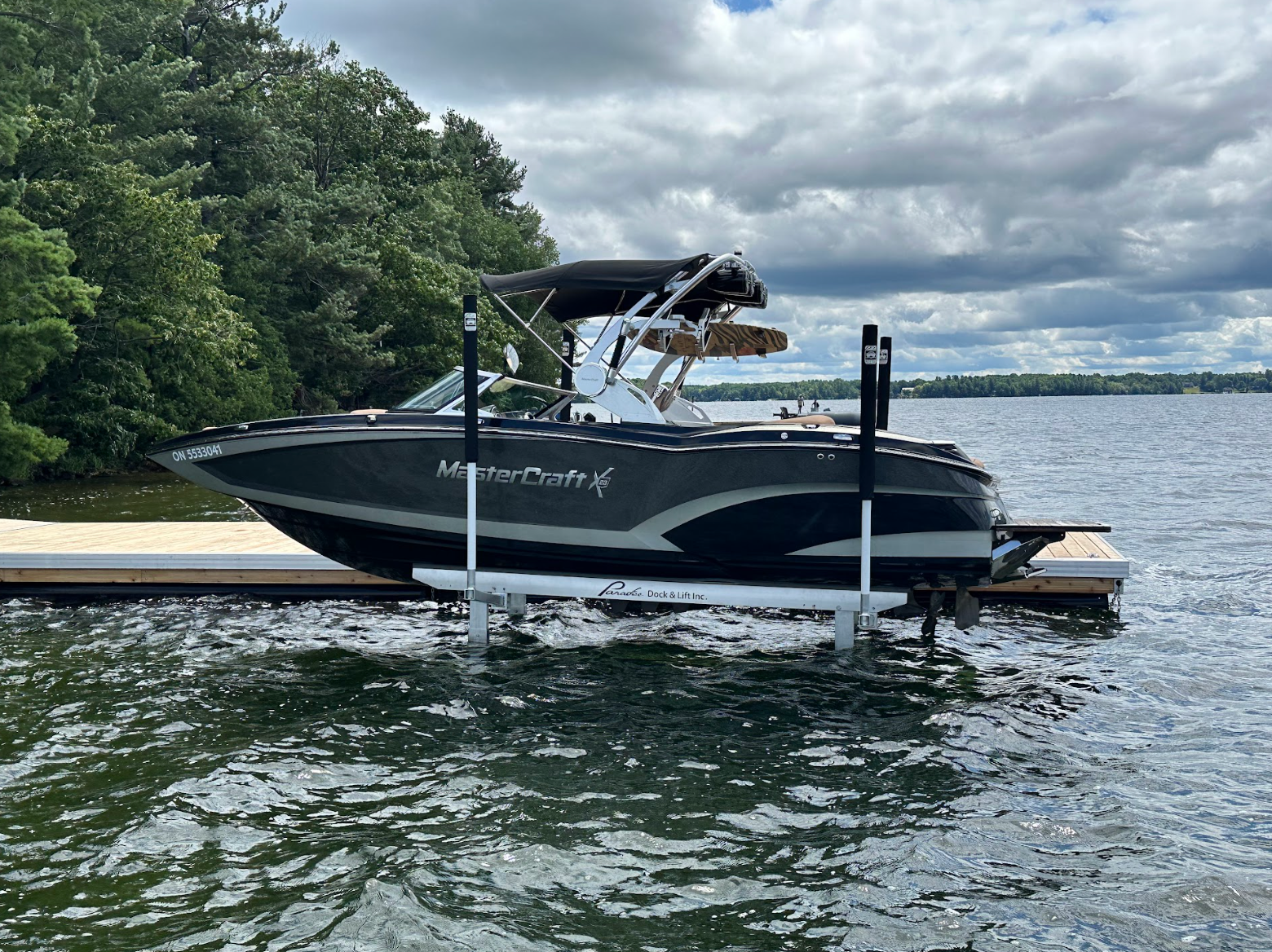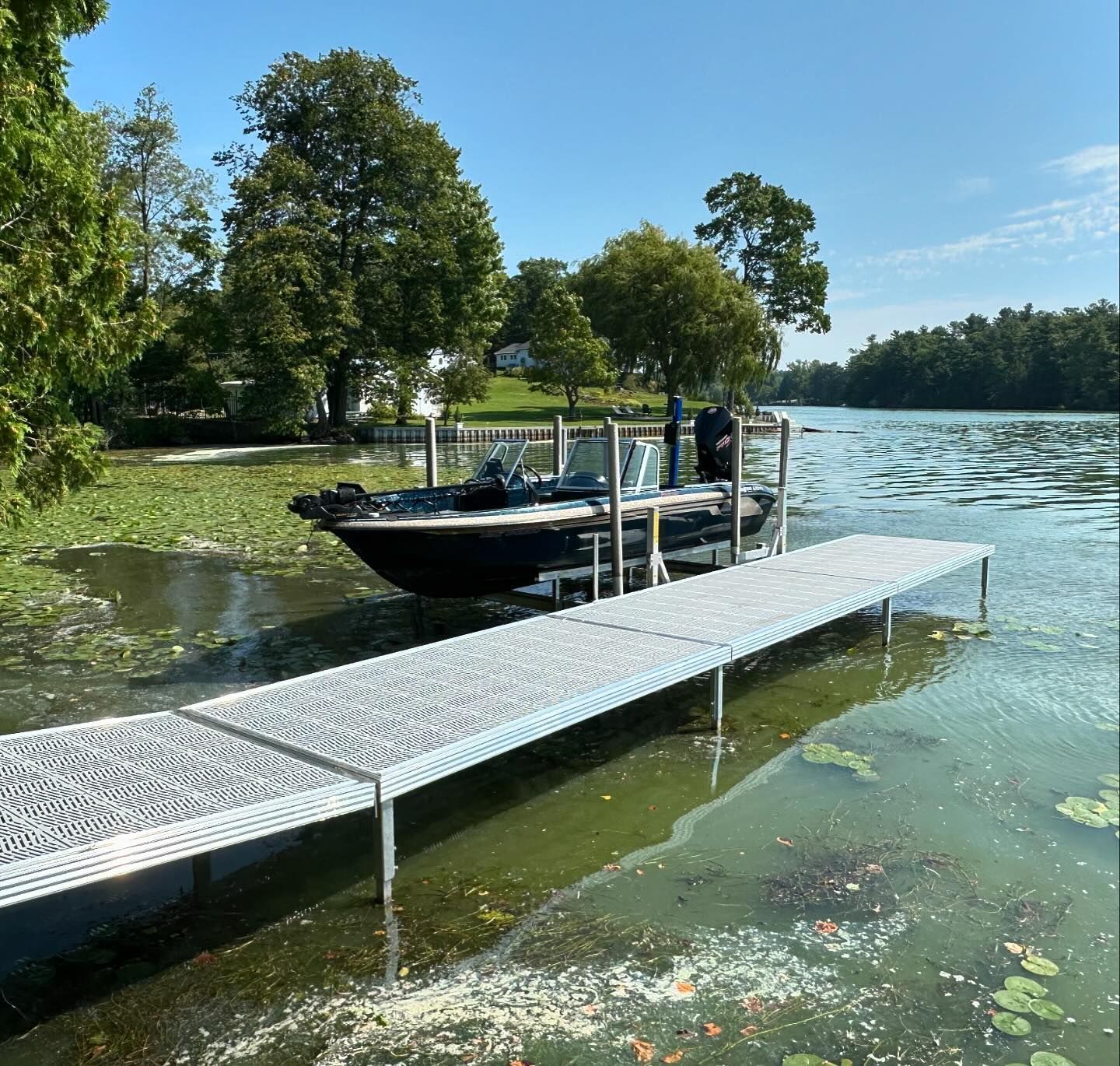(613) 531-1839
Rideau Lakes
2612 Myers Rd., Portland, ON K0G 1V0

Choosing the Best Boat Lift for Your Waterfront Property
Owning a boat is a privilege that comes with its own set of responsibilities. One of the most crucial aspects of boat ownership is ensuring that your watercraft is well-maintained and protected when not in use. A boat lift is one of the best investments you can make for your waterfront property, as it helps to safeguard your boat from damage, extends its lifespan, and makes docking and launching much more convenient. But with so many options on the market, how do you know which boat lift is right for you?
In this guide, we’ll explore the different types of boat lifts available, the key factors to consider when choosing one, and how to maintain your boat lift for long-term use.
Understanding Boat Lift Types
Boat lifts come in several styles, each designed for specific water conditions and boat sizes. Here are the most common types:
- Cantilever Lifts: Cantilever lifts are ideal for shallow water. They use a system of pulleys and leverage to raise and lower your boat. Cantilever lifts are known for being cost-effective and simple to operate, making them a popular choice for smaller boats. However, they are not ideal for deeper waters or areas with fluctuating water levels.
- Vertical Lifts: Vertical boat lifts are best suited for properties with varying water levels. They raise the boat straight up and are highly versatile, accommodating a wide range of boat sizes. Vertical lifts are commonly used in areas where water levels rise and fall, such as lakes and rivers.
- Hydraulic Lifts: If convenience is your top priority, hydraulic lifts are the way to go. These lifts operate with the push of a button, using fluid power to raise and lower your boat effortlessly. Hydraulic lifts are especially useful for larger boats, and they offer a high level of convenience for frequent boaters.
- Floating Lifts: Floating boat lifts are ideal for deep water or docks that can’t accommodate a fixed lift. These lifts are buoyant and rise and fall with the water levels, making them an excellent option for waterfront properties with significant depth.
Each type of lift offers unique benefits depending on your property and boat size. For more details on our hydraulic lifts, check out the products we offer.

Key Factors to Consider When Choosing a Boat Lift
When selecting a boat lift, several critical factors come into play:
- Boat Weight and Size: One of the most important factors is ensuring the lift can support your boat’s total weight, including the vessel itself, any fuel, gear, and potential passengers. Oversized boats may require custom solutions, and our custom boat lifts are designed to handle various sizes.
- Water Depth: The depth of the water where your dock is located plays a significant role in determining the type of lift you need. For instance, shallow waters may require a cantilever lift, while deeper waters often benefit from a hydraulic or vertical lift. Additionally, consider factors such as waves, wind exposure, and water currents.
- Dock Compatibility: Some docks are more compatible with certain types of boat lifts. For example, floating docks pair well with vertical or hydraulic lifts, while fixed docks can accommodate cantilever or tower lifts. It's essential to consider how your dock will work with your boat lift to ensure a seamless setup.
- Durability and Materials: Look for boat lifts made from high-quality materials like aluminum or stainless steel, which resist corrosion and wear, especially in saltwater environments. Investing in durable materials will reduce maintenance costs and ensure your lift lasts for many years.
- Boat Lift Accessories: Customizing your boat lift with accessories such as guide-ons, motor stops, or covers can enhance your overall boating experience. These additions can improve docking precision, protect your boat, and extend the lifespan of both the lift and your vessel.
For more information on choosing a boat lift to fit your needs, check out this guide from BoatUS.
Why Invest in a Boat Lift?
A boat lift is more than just an accessory for your waterfront property. It offers several key benefits that make it a worthwhile investment:
- Protection from Damage: When your boat is left in the water for extended periods, it is exposed to a host of damaging elements, including algae, barnacles, and corrosion. A boat lift keeps your boat above water when not in use, preventing these issues and reducing the need for frequent cleaning.
- Avoiding Collision Damage: Fluctuating water levels can cause your boat to bump against the dock or other submerged objects, leading to costly damage. A boat lift keeps your boat securely in place, even during storms or rough waters.
- Convenience and Accessibility: Hydraulic lifts make it easy to launch your boat with the push of a button, saving you time and effort. If you’re a frequent boater, the convenience of a hydraulic lift is unmatched, allowing you to get on the water quickly without the hassle of manual operation.
- Extending the Lifespan of Your Boat: Keeping your boat out of the water when it’s not in use reduces wear and tear, helping to preserve its condition and extend its lifespan.
Boat Lift Maintenance Tips for Long-Term Use
Even the best boat lifts require regular maintenance to ensure they continue to function properly. Here are some essential tips for keeping your lift in top condition:
- Routine Inspections: Regularly check the cables, pulleys, and structural components of your lift for signs of wear or corrosion. Replacing worn parts promptly can prevent larger, more costly issues down the line.
- Lubrication: Ensure that moving parts, such as the winch and pulleys, are properly lubricated to maintain smooth operation. Neglecting lubrication can lead to friction and damage over time.
- Cleaning and Rust Prevention: If your lift is exposed to saltwater, it’s important to rinse it regularly to prevent rust and corrosion. Stainless steel and aluminum lifts are more resistant to rust, but even they benefit from regular cleaning.
- Winterization: If you live in a colder climate, it’s crucial to prepare your lift for winter. This may involve removing the lift from the water or securing it to avoid damage from freezing temperatures and ice.
For a detailed guide on maintaining your boat lift, check out this seasonal boat lift maintenance guide.
Why Professional Installation Matters
Installing a boat lift can be a complex process that requires precise measurements and expert knowledge. A poorly installed boat lift can lead to operational issues, damage to your boat, or even safety hazards. That’s why it’s essential to have your boat lift professionally installed.
At C&M Superior Systems, we specialize in customized, professional installations tailored to your unique waterfront property. Our team ensures that your lift is aligned correctly and operates smoothly, giving you peace of mind and protecting your investment.
Ready to install a boat lift? Explore our boat lift solutions and let our experts guide you through the process.



